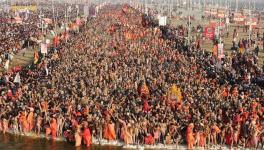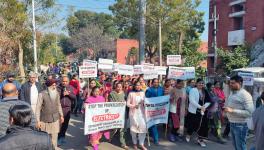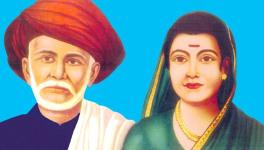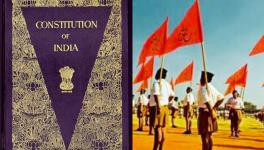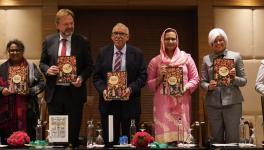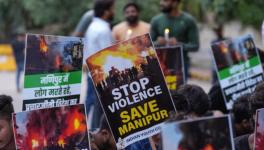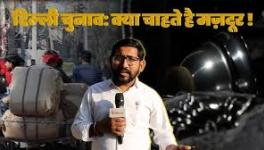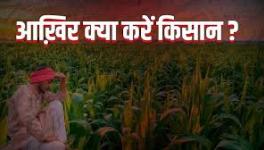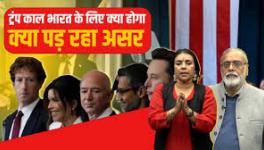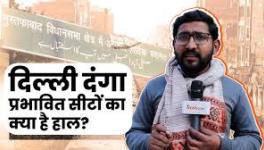Parbhani Violence: Looming Dark Shadows of Police Brutalities, Caste Bias
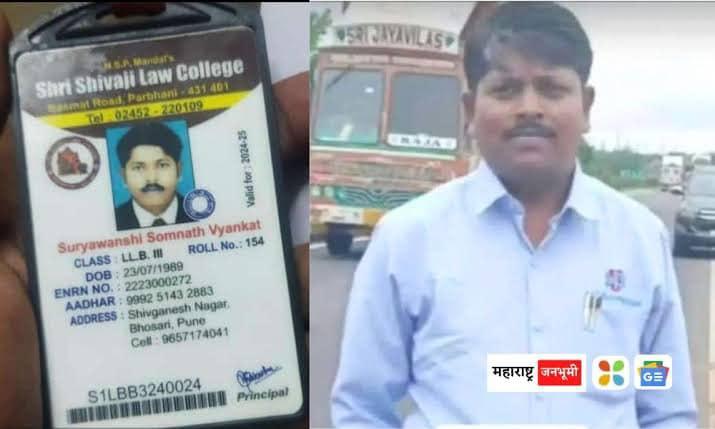
Somnath Suryawanshi died in custody, leading to widespread outrage and protests in Parbhani, Maharashtra, in December 2024. Image Credit: Mangesh Dahiwale/Facebook
An independent fact-finding report on police violence in Maharashtra’s Parbhani in Marathwada in December 2024, reveals the communal, casteist and biased culture of the law enforcement personnel against the deprived and excluded sections of our society.
With the efforts of a team of Ambedkarites and Marxists, the report, titled Unfettered Police Brutalities: Parbhani, has exposed violence against the “alleged mob” who marched toward the district collector's office after a series of events that took place in Parbhani, leading to the death of one person in custody. The protest and violence took place after a person desecrated a replica of the Constitution in the hands of BR Ambedkar in a statue outside the railway station.
The independent report was brought out by a team of social activists, advocates and ‘conscience-keepers’, Abhay Taskal, Pawan Jhondle, Sudhir Salve, Vikas Gaikwad, Preetam Ghaghve and Rahul Pradhan, who interviewed victims of “combing operations” conducted by the police. They were supported by social activists Teesta Setalvad and Raju Parulekar. Along with the interviews and statements of victims, the 103-page report also relied on information and inputs of independent journalist, Sharmila Bhosale.
The Background
A meeting of a Hindu extremist group, Sakal Hindu Samaj, was called in Parbhani on December 10, 2024. Soon after the meeting, a replica of the preamble of the Indian Constitution was desecrated allegedly by one Dattan Sopan Pawar, who was declared “mentally deranged” and a “lunatic” by police officials and an FIR was lodged against him.
As the news of the incident spread, outraged Bahujan called for a state-wide bandh (shutdown) the very next day of the incident to register their anger against “Brahmanical and Hindutva” forces. The report gives a timeline of the events that led to a mob of 100 agitators who “allegedly went on the rampage and ransacked the DM’s office, tore documents there, and damaged the furniture amidst sloganeering”.
The police reached the place an hour later, as per the report, and subsequently controlled the scene. Section 163 of the BNSS (Bharatiya Nagrik Suraksha Sanhita) was imposed at the spot. What happened next was a series of police brutalities unleashed against the Bahujan protesters.
Entitled and empowered as a “regressive state apparatus”, the police worked to perpetuate the ruling ideology against the powerless through the instrument of violence and coercion. The harshest possible action was taken by the local police to “discipline” the alleged mob, the report found.
The ‘combing operation’ carried out by the police in Dalit bastis was akin to a full-fledged war against declared enemies of the state, the report said. Somnath Suryawanshi, one of the 40 detainees/arrestees, was killed in the police custody allegedly after succumbing to injuries due to police torture. On December 12, 2024: “The detained/arrested accused were brought to the Magistrate Court. Their injuries were unmistakable: bleeding, swollen limbs, and other visible signs of torture, but the accused (victims of custodial violence) were afraid of speaking to the judge. The court granted two more days of police custody”, the report says.
Further detention worsened the injuries of the victims, the report found. The Magistrate, thereafter, transferred the victims to the MCR. On December 14, Suryawanshi and the other arrestees were transferred to judicial custody. The very next morning by 6:49 a.m, Suryavanshi died in judicial custody, a day after police custody.
Suryawanshi’s mother, Vijayabai, was informed about the tragic death of her son in custody. The preliminary post-mortem report stated that the reason behind his death was “shock following multiple injuries”. His last rites were witnessed by the huge crowd of Dalit/Bahujans.
The entire episode of police brutalities unleashed caused intense trauma among the oppressed sections. Vijay Vakode, an Ambedkarite activist and associate of Suryawanshi, died of a sudden heart attack. It was reported that Vakode, who witnessed the violence on Suryawanshi, was traumatised by the series of events that took place at Parbhani.
After the massive outrage, Maharashtra Chief Minister Devendra Fadnavis declared financial aid for the family of Suryavanshi. This is a common tradition of the ruling class in a failed state, where the legal authority consumed by Brahmanism and capitalism offers financial aid to the victims as a token, aimed at reducing humans to mere “identities” and “subjects”, said the report.
“Rs 10 lakh is passed on to us casually so police can beat and kill our sons,” Vijayabai Suryawanshi told the fact-finding team.
Suryawanshi belonged to a working-class family. His mother educated him while working as a construction worker. He belonged to the Waddar community, a denotified tribe, which traditionally works as labour for stone crushing. The Waddar community makes up a huge part of the construction industry.
It was on the morning of December 15, 2024, that Vijayabai was informed about her son’s death under detention. The police officials inquired about the “caste” of the deceased’s family. This depressing and inhumane conduct of the police demonstrates their “caste ridden consciousness”. Vijayabai said she was constantly pressured by senior police officials to not perform the last rites of the deceased. Fearing public unrest and political instability, the police reportedly told Vijayabai that she would be held responsible if riots occurred at the funeral site. Vijayabai responded by saying, “My son was in your custody for five days. For five days, you did not contact me. It was only after his death that I was informed.” She asked: “Will you take responsibility from the time of the arrest until his death? Who will take responsibility? You won't take responsibility for his death while in your custody, and yet you ask me to take responsibility for 70,000 people?” ( as cited in the report).
The Report’s Suggestions
The fact-finding report has come out with various suggestions, some of which are:
- On the basis of the complaints, FIRs should be immediately lodged against the police officials involved in the violence and combing operations. They shall be suspended and the detailed investigation be called upon under the surveillance of the High court.
- The victims of the Combing Operations should be immediately compensated and other two sons of Vijayabai be provided with the government jobs.
- The meetings of the Sakal Hindu Morcha be investigated under the eyes of retired high court judges.
- The public life and political connections of the Dattan Sopan Pawar (who allegedly desecrated the replica of the Constitution) be made public and the individuals involved in ‘instigating’ him be prosecuted.
The Preliminary Findings
Some highlights of the preliminary findings of the fact-finding report are:
- The police officials itself let the conditions continue to be worsened and had “equal involvement” as that of Hindu Right who instigated the violence.
- All members of the police force responsible for these actions, all those who were on duty and assigned under orders to conduct the combings should be named and identified.
The fact-finding team demanded public disclosure of the names of officials, their duties assigned at the moment of public unrest, Disclosure of all police orders given for police bandobast, preventive action against Sakal Hindu Morcha, information from the police case diary, public disclosure of media materials and video recordings of police actions along with the CCTV footage at the police station be publicly revealed.
Apart from these, several private complaints were filed by the victim survivors. Given below is the crux of the complaints, as per the fact-finding team.
1. Immediate registration of culpable homicide charges against responsible
officers.
2. Strict action under the Scheduled Castes and Scheduled Tribes (Prevention of Atrocities) Act.
3. An impartial investigation into the custodial death of Somnath Suryawanshi and related incidents.
4. Protection for complainants against retaliatory threats by police.
Dissent, Authority and Social Movements
Maharashtra has historically witnessed militant democratic social movements by Ambedkarites and Buddhists. These social movements not only focused on material and ethical aspects but also acted as the “custodian of the Indian Constitution”. The underlying predominant relationship of dissent and authority in these political histories of the social movements, has seen the curbing of civil liberties and democratic rights at the mass level.
Whenever the repressive state apparatus appeared indifferent to the sufferings of the masses, dissent as a public response occurred as a consequence. Post-colonial Maharashtra witnessed massive land struggles by Bahujan leaders. During the 1960s and 1970s, the Dalit Panther Party was founded by some young educated working-class youth on the lines of the Black Panther Party of the US. Yet, debatable, but the Dalit Panther movement emerged as the outcome of the violence committed by the State on Dalits and Buddhists.
Reports of the Elayaperumal Committee revealed caste atrocities committed against the oppressed sections. These social movements were fuel to the social justice movement against the ruling ideology. During the Marathwada movement, every possible measure was taken by the ruling regime to suppress the resistance, but the dissenters emerged victorious and the university was renamed after Babasaheb Ambedkar.
While social unity among the marginalisd sections grew stronger, the State, through its institutions, kept instigating violence to “discipline” and curb public dissent. The progenitors of the ruling ideology are always assisted by institutions such as police. The Khairlanji Massacre is a horrifying collective memory. Bhaiyalal Bhotmange, lone survivor of the family, is still awaiting justice. These incidents shouldn't be seen as individual cases, instead, these cases of caste violence to tell a larger story. The family of Bhotmange was not leading any social movement, it just posed resistance to the ruling ideology and its harbingers.
The ‘combing operations’ that were unleashed in Dalit settlements in Parbhani by the police were never meant to assert constitutionality. The bastis were destroyed because the action was directed toward silencing dissent. Police went there as the ideological army of the ruling class.
Independent journalist Sharmila Bhosale described the Parbhani caste violence as the, “They Came like Monkeys; they came like Nazis”. The sudden death of Wakode reminds us about Vilas Ghogre, who saw his own people being shot dead at Ramabai Nagar while protesting against the desecration of the Ambedkar’s statue. He died by suicide as dissent against the brutal killings by the police state.
The chain of events in Parbhani brings to us the story of State institutions exercising blatant violence to curb and discipline the working-class masses. However, despite rigorous political and police pressure, Vijayabai stands tall against the perpetrators of caste violence.
The writer is pursuing Masters in political science at the Department of Political Science, Delhi University. The views are personal.
Get the latest reports & analysis with people's perspective on Protests, movements & deep analytical videos, discussions of the current affairs in your Telegram app. Subscribe to NewsClick's Telegram channel & get Real-Time updates on stories, as they get published on our website.









